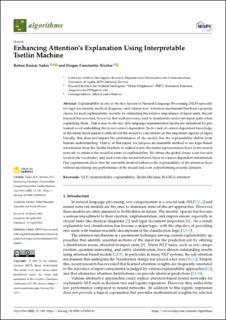Enhancing Attention’s Explanation Using Interpretable Tsetlin Machine
Journal article, Peer reviewed
Published version
Permanent lenke
https://hdl.handle.net/11250/3030688Utgivelsesdato
2022Metadata
Vis full innførselSamlinger
Originalversjon
Yadav, R. K. & Nicolae, D. C. (2022). Enhancing Attention’s Explanation Using Interpretable Tsetlin Machine. Algorithms, 15 (5): 143, 1-13. https://doi.org/10.3390/a15050143Sammendrag
Explainability is one of the key factors in Natural Language Processing (NLP) specially for legal documents, medical diagnosis, and clinical text. Attention mechanism has been a popular choice for such explainability recently by estimating the relative importance of input units. Recent research has revealed, however, that such processes tend to misidentify irrelevant input units when explaining them. This is due to the fact that language representation layers are initialized by pretrained word embedding that is not context-dependent. Such a lack of context-dependent knowledge in the initial layer makes it difficult for the model to concentrate on the important aspects of input. Usually, this does not impact the performance of the model, but the explainability differs from human understanding. Hence, in this paper, we propose an ensemble method to use logic-based information from the Tsetlin Machine to embed it into the initial representation layer in the neural network to enhance the model in terms of explainability. We obtain the global clause score for each word in the vocabulary and feed it into the neural network layer as context-dependent information. Our experiments show that the ensemble method enhances the explainability of the attention layer without sacrificing any performance of the model and even outperforming in some datasets.

